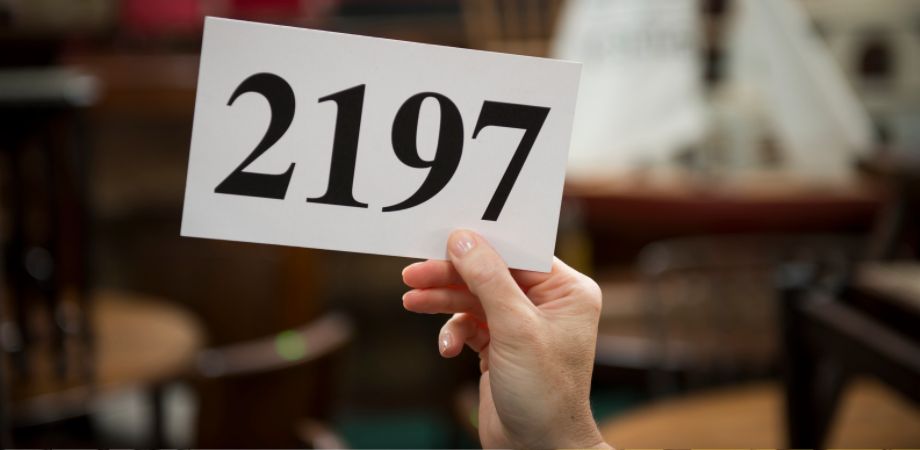Silent auction rules

Are you about to attend your very first silent auction? Perhaps you’re considering hosting one to raise funds after hearing how exciting they can be. If so it’s important that you brush up on your silent auction rules, as they may have changed over the years, especially with the introduction of mobile bidding and virtual events.
Events with any type of bidding require clarity for those in attendance, so it’s important you brush up on your own knowledge beforehand!
If you need more help and advice for your auction, see our recent blogs on how to run a silent auction and silent auction bid sheets.
Running a silent auction?
Knowing exactly what type of fundraising event you’re running is the first step in the right direction. Silent auctions aren’t the same as your typical auction. Guests won’t have a paddle to wave around, there isn’t a man standing behind a lectern rambling numbers, and more than likely, there won’t be rows of seats filled with random guests.
A typical silent auction event requires you to imagine more of a gala. Tables with seating arrangements, a three-course dinner and an impressive dress code. Any successful silent auction will have all three, plus a wide variety of fantastic prizes to bid on.
A silent auction is conducted throughout the evening and often with prizes on display for all to see. Each auction item will be in clear view and approachable (to a certain extent). Those in attendance will be able to walk around each item throughout the evening and bid on those they wish to take home. Often the bidding process is done in secret – hence the title of ‘silent’ auction.
Paper-based silent auction
For a paper-based silent auction, bids are submitted alongside a bidding name or number and placed in a sealed box, with winners confirmed at the end of the night.
The winning bidder is the person who made the highest bid. It’s a great way to get a bargain but also a safer way to ensure your bid isn’t driven up by competitors.
Mobile bidding for a silent auction
Mobile bidding for a silent auction is exactly that – guests are able to use their mobiles to bid on the silent auction electronically. Using this method has a number of great advantages:
- Guests don’t need to continue to leave their seats to few the different auction items, all images and descriptions can be shown online
- Guests can be notified if they are outbid via a sms message and/or email
- Payment can be instantly collected
The big difference here is that instead of the auction now being ‘silent’, guests can see if they are the winning bidder and informed if they are outbid. For the majority of events history shows following this method drives up bidding, competition and funds raised! That said, if guests do want to remain anonymous, they are able to do so.
Sealed bidding using mobile technology
The final option to consider for a silent auction is to actually combine the two – the secrecy of a paper auction, but the ease, fun and engagement of mobile bidding. This is called sealed bidding!
Sealed bidding using mobiles involves only showing the number of bids placed on an item, as opposed to the highest bid and name of the current winning bidder. Throughout the auction, the number of bids received will be displayed on an item, but bidders won’t be aware who the highest bidder is. The idea is that bidder’s are encouraged to place their best bid first, however when a guest sees a lot of interest in an item they have also bid on, it encourages them to ‘up’ their bid, which they can do as many times as they want to.
See here for more information on sealed bidding.
Signing up to mobile bidding
Registration rules for your bidder should be written in a format where they can electronically sign and acknowledge during the bidding process. This might appear like typical terms and conditions but will be essential in enforcing the rules of the event.
The rules surrounding bidding should be stated on your fundraising site. Let attendees know how long they will have to bid on an item and allow them to sign up for notifications on when bidding will end. We would also advise that you create a mechanism whereby payment information must be submitted alongside a bid, rather than waiting for bidding to close. This way payments are securely held and there is no issue receiving payment.
Mobile auctions are designed to be streamlined so in order to make sure the checkout process is as quick as possible, but as a rule, guests will need to enter some personal information. Don’t be surprised that an online silent auction will ask for personal details in order to make the event run smoothly.
Silent auction rules for your event
Having rules for your event is essential if it is to go ahead without any confusion. So be sure to notify all your guests of them upon their arrival. They can either sign a disclaimer to say they have read and understood, or it’s a tick box if you’re using mobile bidding. This is a rule within itself, but here’s a few more for consideration:
- Items may be added or withdrawn without notice. This means that even due to the most unforeseen circumstances, you will be covered when it comes to last minute withdrawals and additions. While some guests may be frustrated, having it written in the rules of your event gives your event security.
- All sales are final. When the hammer comes down in a traditional auction, payments must be made. It is essential that all sales are final in a silent auction also. In some cases, you may need to resort to the second highest bid, but we would suggest keeping ‘all sales are final, no refunds or exchanges unless noted’ in your rules to help prevent any returns.
- List all of your items ‘sold as seen’. This removes any doubt for what the bidder is bidding on. The last thing you will want is to sell an item only for the bidder to claim they no longer want the prize because they ‘didn’t notice an imperfection’. This clause will allow you to enforce a rule of ‘all sales are final’ with a clear conscience that it was down to the bidder to inspect the item, not for you to point flaws out to them.
Silent auction rules for your bidder
Of course, while your event has rules that are to be upheld, each bidder will also have rules for them to note. Their actions throughout the event are essential if it is to go ahead without incident. Make your guests aware of the following rules:
- For paper bidding, bids must be submitted alongside name and bidder number and kept secret to the rest of those in attendance. The whole point in a paper silent auction is to ensure that bids are done in secret. Whispers cannot be uttered to one another during a time when bids are being placed in order to prevent rumors.
- Other rules should also be set out for your guest. Before attending they should be made aware of basic information such as how much a minimum bid is, how to bid, what information is required for each bid and how many bids they may make on a single item (if needed).
- Guests should also follow any checkout rules in place. Noting that no items will be exchanged without evidence of payment, all items should be collected on the night of the auction unless special arrangements need to be made. We also recommend noting in your rules that any items left at the auction without such arrangements or payments will be claimed back by the organization or sold onto the next highest bidder at the next opportunity.
So there you have it, lots of information on silent auction rules and options! Take a look at our silent auction features to help you run your fundraising event, or simply get in touch to discuss further.
Tim Stansbury
Director and Fundraising Consultant
Tim joined Givergy in 2010, overseeing the early stage growth of the business to 50 employees across five international regions, supporting over 4,000 events worldwide. With a passion for leadership, business growth and exceptional standards, Tim is at the heart of all clients needs both in the UK and worldwide.
Examples of Nonprofit Fundraising Events + Best Practices
June 20, 2025
Planning an Animal Charity Event: 4 Tips for Success
June 20, 2025
Event Fundraising Just Got Easier: 5 Powerful Features of the Givergy Event App
June 17, 2025
21 Silent Auction Basket Ideas That Actually Raise More
May 23, 2025
The Ultimate List of Tennis Club Fundraising Ideas
May 19, 2025

